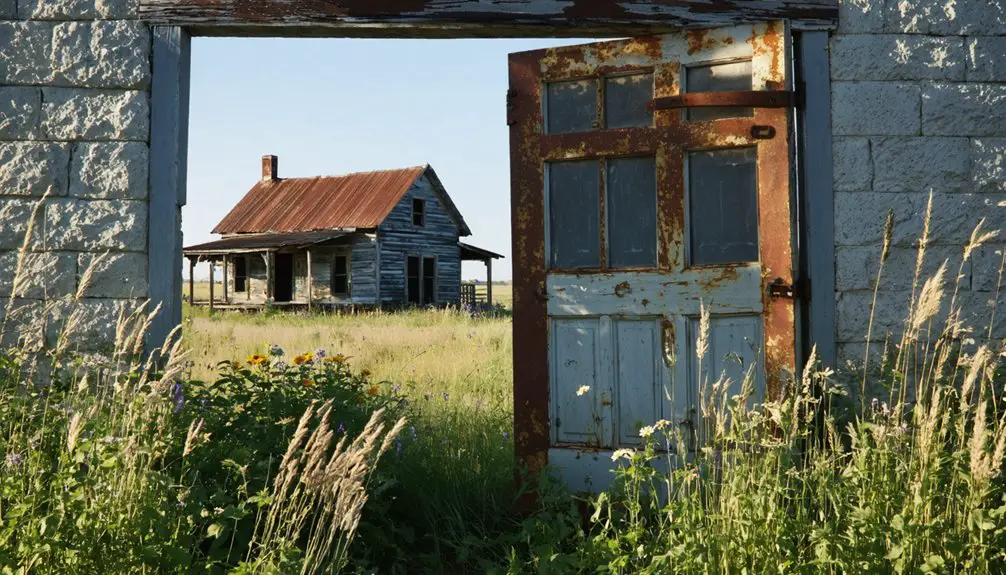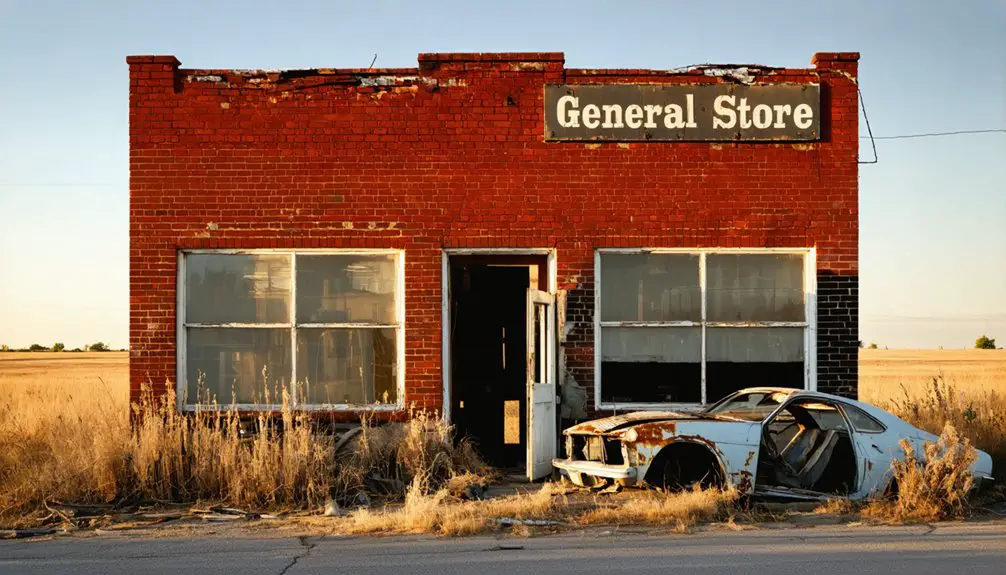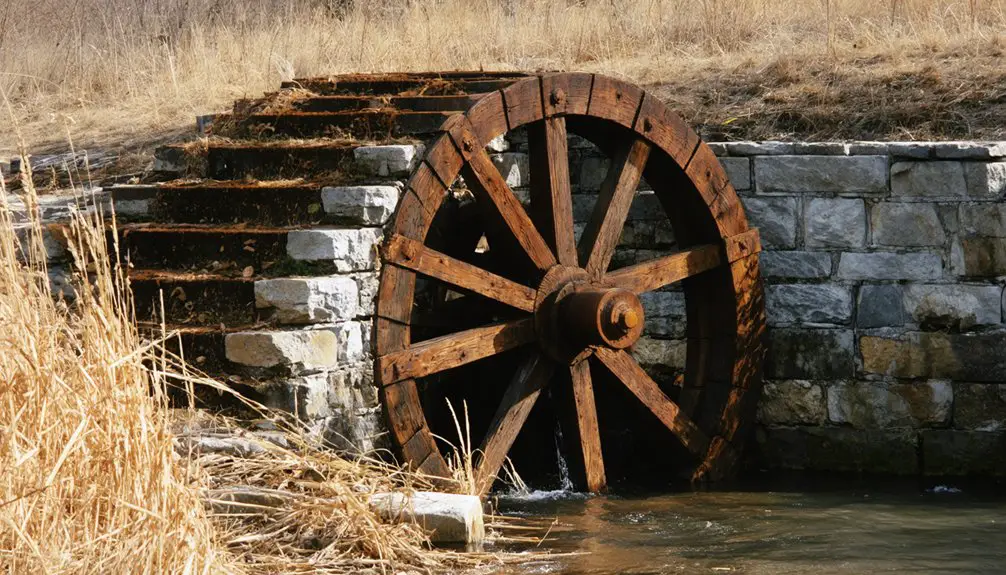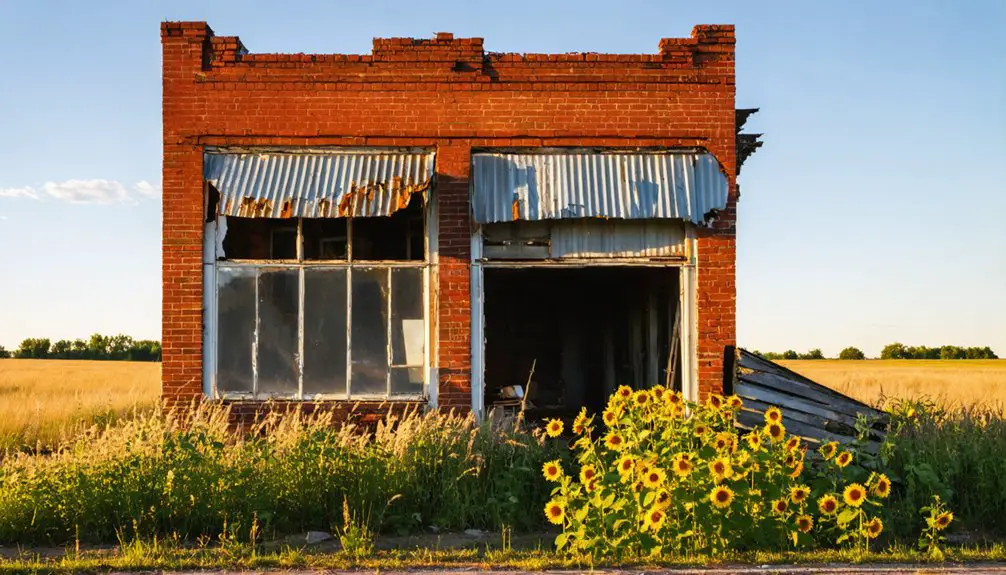You’ll find Afton’s ghost town remains in Marshall County, Kansas, where German Catholic settlers first established a thriving community in the mid-1800s. The town peaked between 1900-1930, when railroads transformed it into a bustling agricultural hub with brick plants, grain elevators, and mills. Today, only scattered architectural remnants persist, including the Horse Creek Bridge and fragments of Route 66-era buildings. The town’s fascinating evolution from frontier settlement to abandoned railway stop holds many untold stories.
Key Takeaways
- Afton transformed from a thriving German Catholic settlement and railroad hub into a ghost town after its peak population of 1,518 in 1920.
- Historical structures like Horse Creek Bridge, Gray Garage, and Acme Court remain as deteriorating remnants of Afton’s prosperous past.
- Nature has reclaimed much of the town, with wild brush overtaking former gardens and sand burying most railroad tracks.
- Most original buildings are now hazardous for exploration due to structural decay, with staircases particularly vulnerable to collapse.
- The town’s legacy persists through historical records, cemeteries, and its significance along the Old Kaw Trail and Route 66.
Early Settlement and German Heritage
While German Catholic settlement flourished across Kansas in the mid-1800s, the area near Afton gained particular significance through its connection to the Benedictine Abbey established in Doniphan County in 1857.
You’ll find that German immigration shaped northeast Kansas profoundly, with settlements like St. Benedict in nearby Nemaha County drawing settlers primarily from Oldenburg, Germany. The Wolf River settlement became another important German Catholic community in Doniphan County.
The region’s story reflects broader patterns of cultural assimilation among German Catholics in Kansas. Unlike some areas where German dialects persisted into the mid-1900s, most families near Afton stopped using German at home before World War I.
The rapid decline of German language use near Afton deviated from other Kansas settlements, where mother-tongue dialects endured for generations.
Yet, the German heritage left an indelible mark through religious institutions, farming practices, and community structures that defined early settlement patterns in the region. The construction of the Atlantic and Pacific Railroad in 1871 brought significant changes to the local settlement patterns.
The Rise of a Rural Community
As railroad expansion brought new opportunities to northeast Kansas in the late 1800s, Afton emerged as a thriving agricultural and commercial hub.
You’d have witnessed remarkable growth as the population surged from 606 in 1900 to 1,518 by 1920, driven by new rail connections and diverse business development.
The town’s community dynamics flourished with two hotels, banks, a brick plant, creamery, and grain elevators by 1911.
Rural migration patterns shifted significantly when Appalachian families arrived in the 1930s, injecting youth into the aging population.
You’d have found a well-connected town, strategically positioned on U.S. Highway 60/69 and Historic Route 66, while the Frisco railroad division point guaranteed Afton’s role as a crucial shipping center.
Agriculture and ranching sustained the local economy throughout the early 1900s, with farmers producing wheat, corn, and hay.
Local organizations like the Grange strengthened social bonds through cooperative initiatives and educational programs.
The local community band drew crowds to weekly concerts in the town square, with merchants providing financial support to maintain this cherished tradition.
Railroad Impact and Economic Growth
The Atlantic and Pacific Railroad‘s arrival in 1871 sparked Afton’s transformation from open Cherokee Nation territory into a bustling economic center.
When the Kansas City, Fort Scott & Memphis Railroad joined in 1901, you’d have witnessed remarkable railroad expansion that turned Afton into a crucial transportation hub.
The twin railways drove economic diversification beyond farming, attracting brick and tile plants, grain elevators, and mills. You’ll find evidence of this prosperity in the establishment of two hotels and banks by the early 1900s. Similar to how grain transport flourished at Boonville’s Team Track in the 1920s, railroads enabled efficient movement of agricultural products.
Like the Prairie Spirit Trail today, the railways served as vital community connectors linking towns and facilitating commerce.
The fertile Horse Creek farmlands found new markets through rail shipping, while local manufacturing flourished.
Population soared from 600 in 1900 to 1,279 by 1910, reaching 1,500 residents by 1920 – a reflection of the railroads’ powerful economic impact.
Daily Life in Peak Years
During Afton’s peak years between 1900-1930, daily life centered around a tight-knit community of farming families who’d gather at the local school, church, and ballfield.
You’d find about 100 residents, mostly focused on agricultural practices, working the surrounding farmland much like early settler Peter Schy had done.
Your daily routine would’ve involved visiting the post office, attending community functions at the church, or watching local baseball games.
Children would walk to the schoolhouse, which served both elementary and high school students.
The community enjoyed spending time at Lake Afton which became a popular recreational spot for locals.
Community cohesion remained strong through shared institutions – the cemetery, church services, and school events brought everyone together.
Like other small Kansas towns, residents faced a 30-minute commute to find work opportunities outside the immediate area.
While amenities were basic, you’d have found all essential services needed for rural Kansas life, including postal service until the 1930s.
Landmarks and Historic Buildings
While most buildings have succumbed to time, several notable landmarks still stand as evidence to Afton’s heyday.
You’ll find the Horse Creek Bridge, listed on the National Register of Historic Places, showcasing its distinctive 1936 design with pedestrian walkways and concrete guard rails. The bridge’s historic preservation efforts highlight its architectural significance as a Great Depression-era Public Works Project.
Along Route 66, you can spot the former “Nowhere” restaurant, which maintains its original gas pump island, and the Rest Haven Motel’s faded neon sign. The Gray Garage and Station, with its distinctive rock-faced facade built around 1930, remains a testament to early automotive culture.
The Acme Court from the 1940s anchors the old business district, while the town’s church remains an active community hub. The town’s limestone quarrying provided building materials for many of these historic structures.
These surviving structures, though many repurposed, tell the story of Afton’s evolution from a bustling Route 66 town to today’s ghost town status.
The Path to Decline
Standing alongside these historic structures, you’ll notice signs of a community that gradually lost its energy through multiple challenges.
Like many Kansas ghost towns, Afton’s decline stemmed from a combination of transportation changes and economic factors. The absence of a major railroad connection severely limited the town’s growth potential, while nearby communities with better rail access flourished.
Towns without railroads often withered away as their rail-connected neighbors thrived, leaving behind empty streets and forgotten dreams.
As urbanization accelerated across Kansas, young families moved away in search of better opportunities in larger cities, leaving behind an aging population.
The town’s isolation from major transportation routes made it difficult to attract new businesses or maintain existing ones. Without sufficient investment in infrastructure and services, the community struggled to adapt to shifting economic landscapes, ultimately leading to its abandonment.
Modern Day Remnants

Today in Afton, scattered architectural remnants tell the story of what was once a vibrant Kansas community.
You’ll find original homes of architects and doctors maintaining their structural integrity, complete with period features like built-in bookcases and concrete bathtubs. While staircases still stand, they’re increasingly vulnerable to collapse.
Nature’s relentless march continues its natural reclamation of the town.
You can trace sections of the original street grid, though they’re now mostly hidden beneath vegetation. Sand has buried most railroad tracks, with only isolated stretches still visible. Where manicured gardens once flourished, wild brush now dominates.
The few remaining structures stand as silent sentinels, drawing occasional visitors but hosting no permanent residents. While public access is possible, deteriorating conditions make exploration increasingly hazardous.
Legacy in Marshall County
Throughout the late 19th century, Afton emerged as one of several strategic settlements in Marshall County that shaped northeastern Kansas’s development. You’ll find its cultural significance woven into the fabric of the region’s frontier narrative, from its position along the Old Kaw Trail to its role in early postal networks.
The town’s trajectory mirrors the broader demographic changes that transformed Marshall County, as shifting transportation routes and economic challenges gradually altered the landscape of rural Kansas.
Like many rural Kansas towns, Afton rose and fell with changing transportation patterns and economic tides that reshaped Marshall County.
While Afton’s physical presence has faded, you can still trace its influence through surviving cemeteries, historical records, and local heritage sites.
The town’s legacy lives on in documented stories of settler-indigenous interactions, agricultural endeavors, and community life that characterized northeastern Kansas’s evolution from frontier to settled territory.
Frequently Asked Questions
What Native American Tribes Originally Inhabited the Land Where Afton Was Established?
You’ll find that both the Osage Nation and Cherokee Tribe originally claimed this territory, though the Osage were the primary inhabitants before European settlement pushed them from their ancestral lands.
Were There Any Notable Crimes or Lawlessness Incidents in Afton’s History?
Like a tumbleweed rolling through empty streets, you won’t find specific records of major crimes in Afton’s history, though it likely experienced typical frontier-era lawlessness common to Kansas settlements.
Did Afton Have Any Connection to the Underground Railroad Movement?
You won’t find documented evidence linking Afton’s history to the Underground Railroad. While Kansas was essential to freedom routes, there’s no verified proof that Afton served as a station or stop.
What Natural Disasters Significantly Impacted the Town Throughout Its History?
You won’t find documented evidence of specific flood damage or tornado destruction in this town’s history, though regional floods and Dust Bowl conditions likely affected its farming community like others nearby.
Did Any Famous Personalities or Historical Figures Ever Visit Afton?
You won’t find any documented famous visitors or significant historical connections to this town. Historical records and research show no evidence of prominent figures stopping in this small farming community.
References
- https://www.youtube.com/watch?v=VPZtNoncnig
- https://www.legendsofamerica.com/ok-afton/
- https://en.wikipedia.org/wiki/List_of_ghost_towns_in_Kansas
- https://legendsofkansas.com/marshall-county-extinct-towns/
- https://legendsofkansas.com/sedgwick-county-extinct-towns/
- https://www.stmarystbenedict.org/About-Us/History/a-summary-of-german-immigrants-to-northeast-kansas
- https://swissmennonite.org/wp-content/uploads/2018/11/german-heritage.pdf
- https://esirc.emporia.edu/bitstream/handle/123456789/1574/Lindquist Vol 7 Num 4.pdf?sequence=1
- https://www.youtube.com/watch?v=d1-fyfM9fR4
- https://www.okhistory.org/publications/enc/entry?entry=AF005



